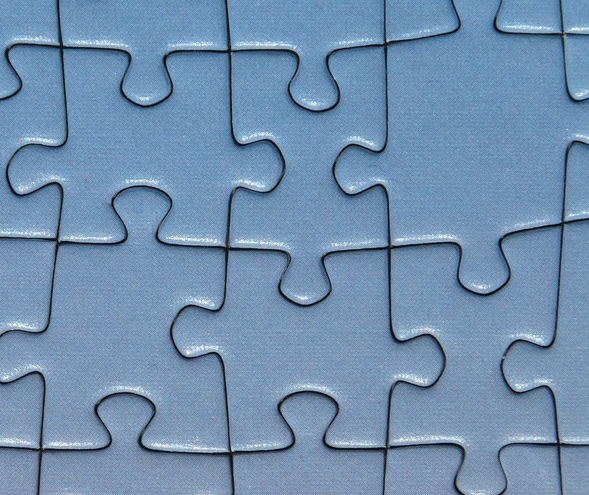Shapes & Politics of Puzzle Pieces
I'm not the most avid jigsaw puzzle player you'll ever meet, nor do I pride myself in being a very good one. But I generally like games, and when somebody tricks me into working on a nice puzzle set I can end up spending a long time on it. My wife Mariana doesn't quite share my fixation, and my dad is a hardcore non-gamer, but whenever my mom, sisters or Olimpia are around (EDIT: and the kids are asleep!!) it's fun for hours. But those hours can turn into days, and if it's a 5K+ puzzle set, months! The last time this happened we ended up not having anywhere to eat for a week — after which we decided to just lay place-mats on top of the half-assembled puzzle.
Not being a connoisseur, I have never done any research into formal strategies for solving puzzles. I do start by separating edges first (but not the corners, which are statistically impossible to find, and which end up showing up in the edge collection anyway). As a team, I find we usually try and separate pieces according to the obvious groupings: color, words, visual features.
Now there's usually a phase in the middle where you get close to losing hope ("all the remaining pieces are of deep blue ocean!!"). That's usually when there are only a few hundred left to place, and there I shift to a different approach: puzzle shaping.
Puzzle Shaping
Puzzle shaping is a technique where you figure out placement primarily by using the shape of the puzzle piece, based on the positions of its tabs and blanks. I use a self-designed standard taxonomy to organize them, and also to communicate with others (who are invariably amused by my naming). I'd like to help others that are stuck by making my naming more widely known.
Here's how my taxonomy works:
| Puzzle | I name this after the classic puzzle shape; two blanks and two tabs opposite each other. |
| Mouse | These have two blanks and two tabs, with the blanks adjacent to each other, and similarly the tabs. Notably, the visible part of Wikipedia's old globe logo is comprised of many Mouse pieces assembled together. Mozilla's add-ons site favicon is a Mouse piece too. |
| Human | Where you have three blanks and one tab; put the tab at the top to see why! |
| Alien | Because three tabs and one blank is the opposite of Human. |
| Cheese | Four blanks, which on a long session might make you remember you're hungry. |
| Splash | Four tabs. Nuff said. |
The cropped image below shows one Splash, one Mouse, two Human and two Puzzle pieces assembled:

Puzzle and Mouse types are by far the most common, while Cheese and Splash are rare enough that they are worth celebrating. I don't have names for the edge pieces, because as I noted before, they are usually placed early enough in the game that shaping isn't very useful. At some point I'd love to read more about puzzle cutting machines to understand how their strategies are implemented. Until then, back to work!
Help us out!
What about you? Do you use any original ways to separate or organize your puzzle pieces? Do you have your own classification scheme that you use, and if you have a shaping taxonomy like me, are your names cuter than mine?
PS: We did have dinner many times on top of that puzzle-piece-laden table. But a friend who was visiting told me about these puzzle roll-up mats, which at the time I doubted even existed. And while they are not uncontroversial, turns out they actually do!
